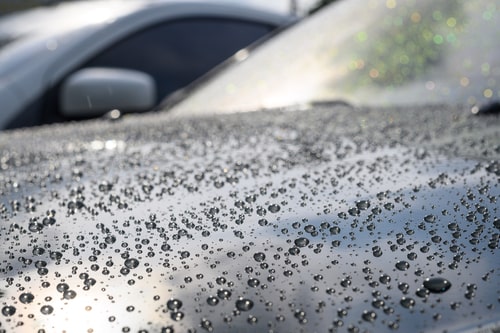Ceramic hydrophobics: Ceramic coatings have revolutionized the way we protect various surfaces, particularly those of cars and other vehicles. One of the key benefits of ceramic coatings is their remarkable hydrophobic properties. This article delves into the science behind what makes ceramic coatings so hydrophobic and how these properties benefit users.
- Composition of Ceramic Coatings
Ceramic coatings are primarily composed of silicon dioxide (SiO2) and other nanoparticles like titanium dioxide (TiO2) or zirconium dioxide (ZrO2). These nanoparticles create a chemical bond with the surface they are applied to, forming an ultra-thin, transparent layer that provides protection and durability. The hydrophobic properties of ceramic coatings can be attributed to the molecular structure and interactions of these nanoparticles.
- Hydrophobicity Explained
Hydrophobicity refers to the ability of a surface to repel water. Hydrophobic surfaces possess a high contact angle between the surface and water droplets, causing the water to form beads and roll off easily. This phenomenon occurs due to the low surface energy and lack of compatibility between the surface and water molecules.
- How Ceramic Coatings Increase Hydrophobicity
When applied to a surface, ceramic coatings form a semi-permanent bond, creating an almost impermeable layer. The nanoparticles in the coating are packed tightly together, making it difficult for water molecules to penetrate the surface. The low surface energy of the ceramic coating further contributes to its hydrophobic properties.
The structure of the coating also plays a significant role in its hydrophobicity. The SiO2 molecules in the ceramic coating bond with the surface and orient their hydrophilic (water-loving) sides toward the surface. This leaves the hydrophobic (water-repelling) sides exposed, creating a surface that repels water efficiently.
- Advantages of Hydrophobic Ceramic Coatings
There are several benefits to using hydrophobic ceramic coatings, including:
- Easy Cleaning: The hydrophobic properties of ceramic coatings make it easier to clean surfaces, as dirt, grime, and other contaminants are less likely to stick to the surface. Water simply beads up and rolls off, carrying dirt and debris with it.
- Reduced Maintenance: With a hydrophobic ceramic coating, surfaces require less frequent washing and maintenance, saving time and effort.
- Enhanced Appearance: Ceramic coatings give surfaces a glossy, smooth finish, which can make colors appear more vibrant and reduce the appearance of scratches or swirl marks.
- Protection: The hydrophobic properties of ceramic coatings help to protect surfaces from water damage, including staining, oxidation, and corrosion.
Conclusion
Ceramic coatings have gained widespread popularity due to their hydrophobic properties, which can be attributed to their unique composition and molecular structure. The hydrophobic nature of ceramic coatings offers numerous benefits, including easier cleaning, reduced maintenance, enhanced appearance, and protection from water damage. Investing in a high-quality ceramic coating is an excellent way to keep surfaces looking great and well-protected for years to come.

